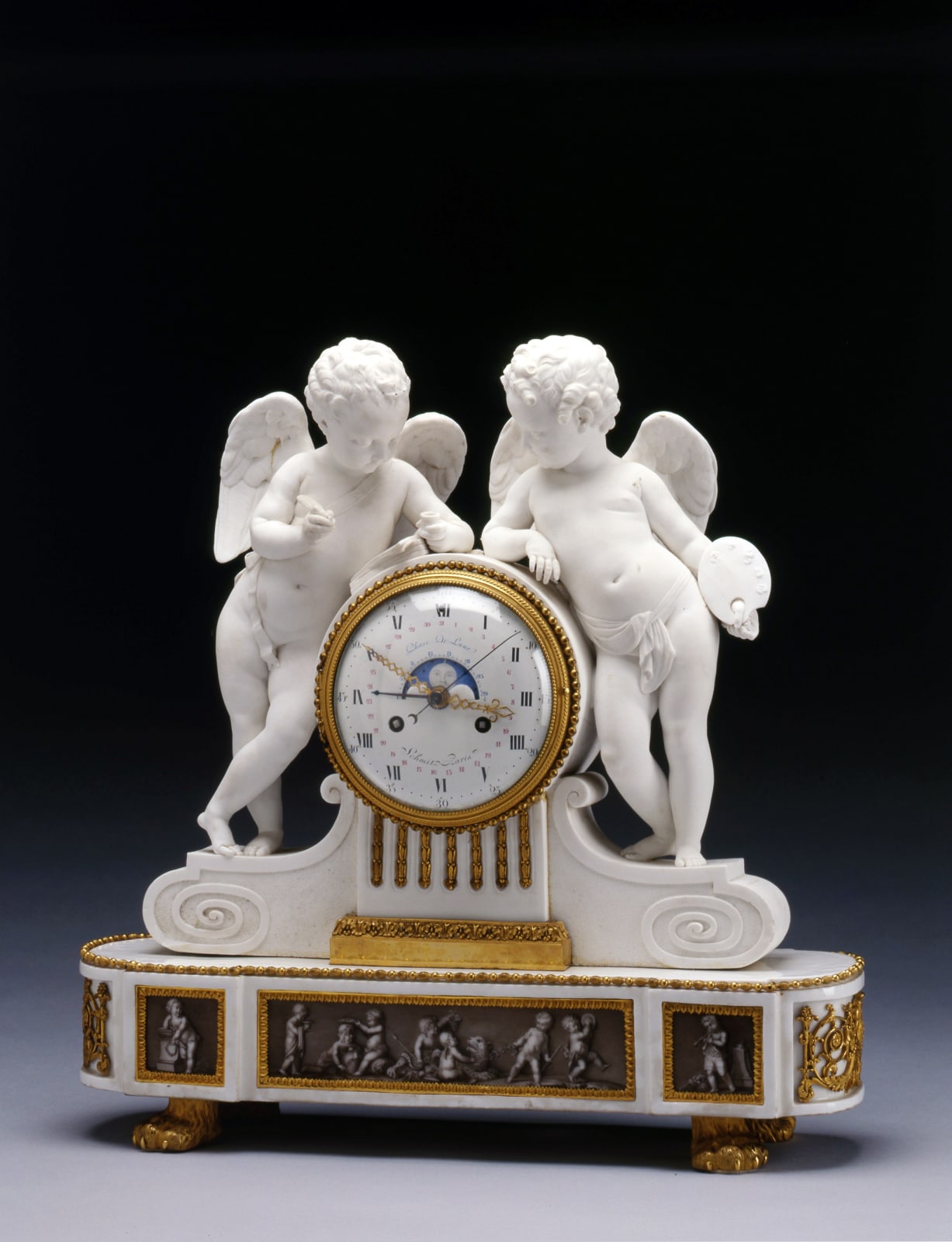Jean-Nicolas Schmit
Literature
Pierre Kjellberg, "Encyclopédie de la Pendule Française du Moyen Age au XXe Siècle", 1997, p. 297, pl. E, illustrating an almost identical case made by the d'Angoulème porcelain factory.
A rare and wonderful Louis XVI biscuit porcelain figural mantel clock of fourteen day duration, signed on the white enamel dial Schmit à Paris. The beautifully executed polychrome dial inscribed Phase De Lune above a star-studded blue demi-moon phase surrounded by blue numerals 1-29, with inner red numerals for the 31 days of the month and outer black Roman and Arabic numerals and a very fine pair of pierced gilt brass hands for the hours and minutes, the hour hand with a fleur-de-lis pointer, with a pair of blued steel pointers for the calendar indications and sweep centre seconds.
The movement with pin wheel escapement, silk thread suspension, striking on the hour and half hour on a single bell, with outside count wheel. The beautiful biscuit case by the d'Angoulême porcelain factory, featuring either side of the dial two standing winged putti as allegories of poetry and painting, the one of the left gazing at an open page, poised as if to write, the other holding an artist's palette while gazing at the open book, the gilt beaded bordered porcelain frieze panels below painted en grisaille featuring bacchic youths at play, showing at centre a panther beside two putti, one of which holds a bunch of grapes and thyrsus, the central group flanked by similar figures including one drinking from a cornucopia, another being crowned, another pulling the panther and yet another playing the cymbals, the central frieze flanked by similar panels with single figures, the whole supported on gilt brass lion paw feet
Paris, date circa 1790
Height 48 cm, width 47 cm, depth 13 cm.
The beautiful case was made by the d'Angoulême porcelain factory, which was established in 1789 by the partners Christopher Dihl and Monsieur Guehard under the protection of the duc d'Angoulême. Recorded in the Parisian rue Bondy (or possibly rue de Temple), Dihl and Guehard specialised in the production of extremely fine quality biscuit and hard paste porcelain as well as jasper plaques in imitation of those produced by the Wedgwood factory in England. The d'Angoulême factory was particularly well patronised by the Garde-Meuble, for whom they supplied biscuit figures and objects priced between 60 to 1200 francs and clock cases ranging from 200 to 6000 francs. Among many objects, the factory made a cup and saucer which was purchase in 1785 by Benjamin Franklin as a gift to his daughter (exhibited at the Carnegie Museum of Art, October 1998-March 1999).
The Parisian clockmaker Jean-Nicolas Schmit (or Schmidt; d. circa 1820) was received as a maître-horloger in August 1781. Two years later he was recorded at rue Betizy and at rue Coquillère on the corner of the rue du Coq-Héron. Later in 1799 he was operating from rue Saint-Martin. Schmit appears to have been the chief supplier of movements to Guehard and Dihl's factory. His name appears frequently on dials housed in biscuit porcelain cases, including another by Guehard and Dihl with figure of Peace as well as two unsigned biscuit cases (though almost certainly by the d'Angoulême factory): one with a young girl seated on a fountain and the other with seated putti representing Learning and philosophy, (illustrated respectively in Pierre Kjellberg, "Encyclopédie de la Pendule Française du Moyen Age au XXe Siècle", 1997, p. 299, pl. E; p. 341, pl. C and p. 342).
G. H. Baillie, in "Watchmakers and Clockmakers of the World", reprinted 1993, p. 285, notes a mantle clock by Schmit in the Château de Compiègne. It appears that Schmit was one of many suppliers to Jean-Baptiste-André Furet (1720-1807), Horloger Ordinaire du Roi pour sa Biblitèque; when Furet declared bankruptcy in 1786 Schmit was named as one of 90 creditors, being owed 10,700 livres. Schmit also presumably supplied the clockmaker Louis-Charles Balthazar (d. after 1789), since he was named as one of the latter's creditors.
